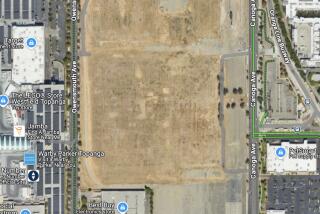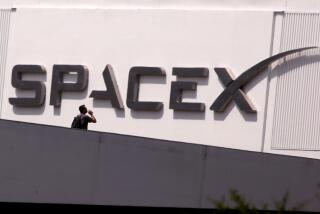Lockheed Launches Attack on Pollution : Aerospace: Seeking to avoid repeat of costly Burbank cleanup, firm is investing in controlling toxics at new Palmdale Skunk Works.
- Share via
PALMDALE — Lockheed Advanced Development Co., the 677-acre complex here known as the Skunk Works, gave the media a peek last week at part of the place: a new, $30-million parts plant that Lockheed boasts is one of the most environmentally safe facilities of its kind in the country.
The plant, which opens next month, will fabricate, prepare and paint metal aircraft parts, including those needed to make modifications to the Lockheed-built F-117 stealth fighter and updating of the old U-2 spy plane.
The Palmdale Skunk Works takes its name from Lockheed’s secret Advanced Development Projects unit originally in Burbank, which for decades has designed and built top secret military aircraft. Employees dubbed it the Skunk Works back in the 1940s, when fumes from a nearby chemical plant filled the unit with a foul smell, and they were inspired by characters in Li’l Abner who operated a moonshine distillery with secret ingredients in their brew.
Lockheed is investing heavily in the latest pollution-control equipment at its Palmdale complex in an effort to avoid another environmental headache like the cleanup under way at its old Burbank facilities. Lockheed said the cleanup could cost as much as $263 million over the next eight years or more.
With the environmental systems at its newest Palmdale plant, Lockheed has invested more than $22 million in such equipment at its new facilities to prevent pollution and minimize hazardous materials and waste.
“We believe this is what it takes to meet all the environmental rules that have evolved over the years,” said Skunk Works Executive Vice President Jack Gordon. “With this facility we have established a standard for environmental protection that other companies will be trying to achieve for years.”
Some environmental officials dispute that claim. “Their systems sound good, but they are not necessarily the first or best in the country,” said Sam Atwood, a spokesman for the South Coast Air Quality Management District.
Indeed, other defense concerns including Los Angeles-based Northrop Corp. and General Dynamics headquartered in Falls Church, Va., have been using some of the same type of air-cleaning equipment for several years. All of them were built by Harrington Plastics Inc., a privately held company based in Chino.
As for worker safety at the new parts plant in Palmdale, “it looks very good, but we can’t tell until it’s in operation,” said Bill Seiner, an official of the California Occupational Safety and Health Administration, who toured the facility last week.
The Palmdale complex is where Calabasas-based Lockheed Corp. is in the process of moving 3,000 employees from Burbank. The move, which began three years ago, is scheduled to be completed next spring. The Palmdale complex will then be a complete aircraft company, capable of taking planes from design to flight-testing.
Most of Lockheed’s environmental efforts in Palmdale have centered on processing parts, in which volatile, organic compounds such as hexavalent chromium are used. Nearly a third of the new metal-parts plant’s cost, or about $9 million, went into state-of-the-art systems that will release no waste water and almost no air emissions.
The recycling systems clean and recycle all water used at the plant for industrial purposes. Air-emission controls will process and remove a minimum of 99.9% of all chromium and 95% of all acid and nitrous-oxide emissions, and an ultraviolet oxidation system for capturing metal-painting emissions will remove 99.9% of all contaminants, according to the company. The plant’s air and water-recycling systems are the latest-generation version of similar systems that Lockheed installed at another of its plants in the Palmdale complex that fabricates and processes parts made of space-age plastic composites.
Like other large defense contractors, Lockheed’s environmental problems in Burbank date back to World War II. At the peak of Lockheed’s military aircraft production in the 1940s, more than 90,000 Burbank employees worked around the clock, assembling planes both indoors and out--with nobody worrying about what was spilled on the ground.
Those environmental problems led to a suit filed against Lockheed by its workers. The huge chemical-exposure lawsuit was brought on behalf of 624 current and former Lockheed workers at its Burbank complex during the 1970s and 1980s. Generally, the workers claimed that solvents, resins and epoxies used at the plant caused maladies ranging from skin rashes and memory loss to cancer deaths.
The Times reported that in 1992 Lockheed agreed to pay $33 million, along with $300,000 to a team of judicial mediators, to distribute the settlement fund among the plaintiffs.
As for the estimated $263-million cleanup of the old Burbank complex, U.S. taxpayers will help foot the bill. Last spring, the General Accounting Office reported that the Defense Department, Lockheed’s largest customer, would reimburse the company for more than half the cost of the work.
Nationwide, the Pentagon has agreed to pay the country’s 15 largest defense contractors for much of the $3.1 billion in expenses they face collectively for environmental decontamination.
More to Read
Inside the business of entertainment
The Wide Shot brings you news, analysis and insights on everything from streaming wars to production — and what it all means for the future.
You may occasionally receive promotional content from the Los Angeles Times.










